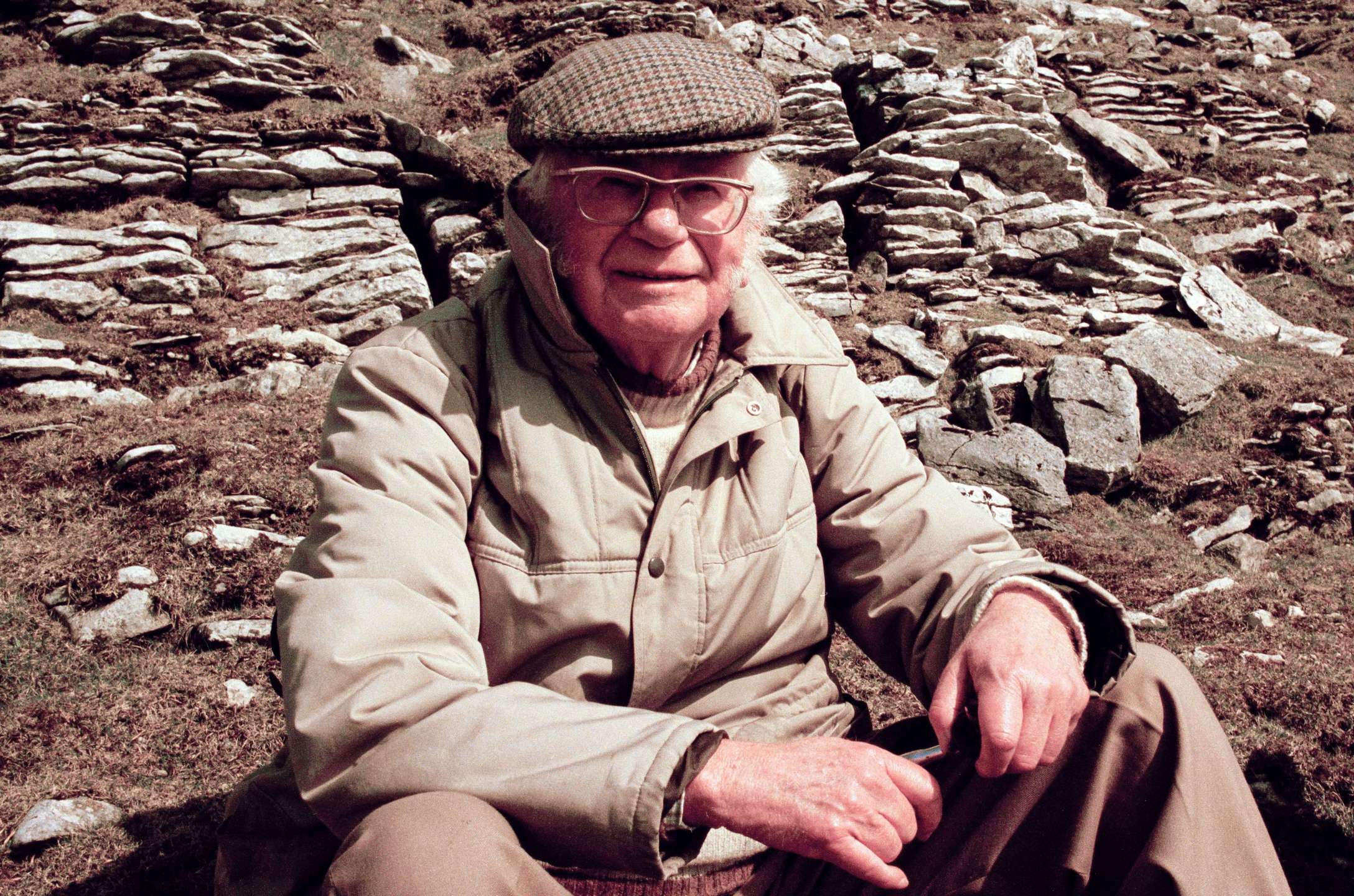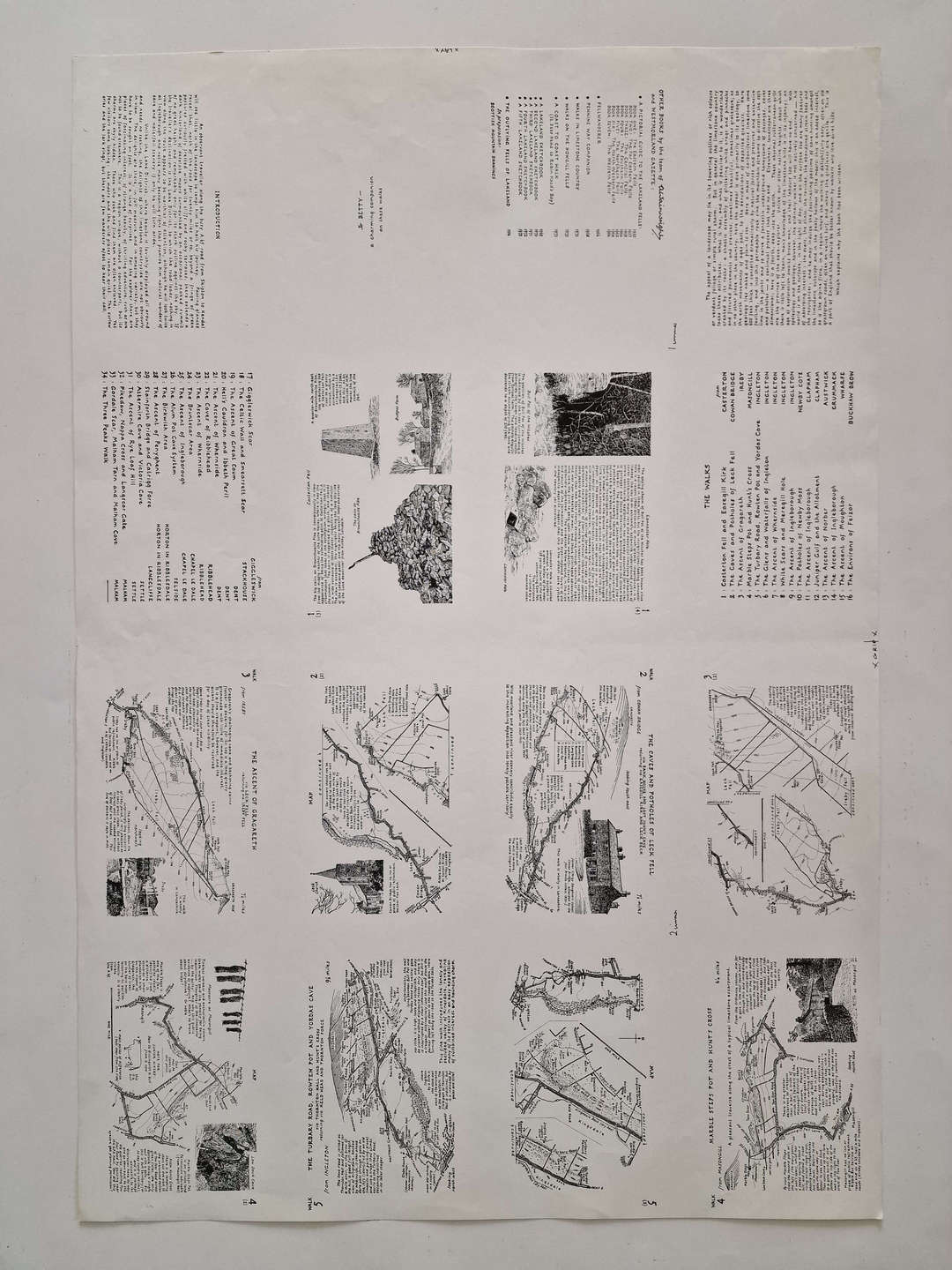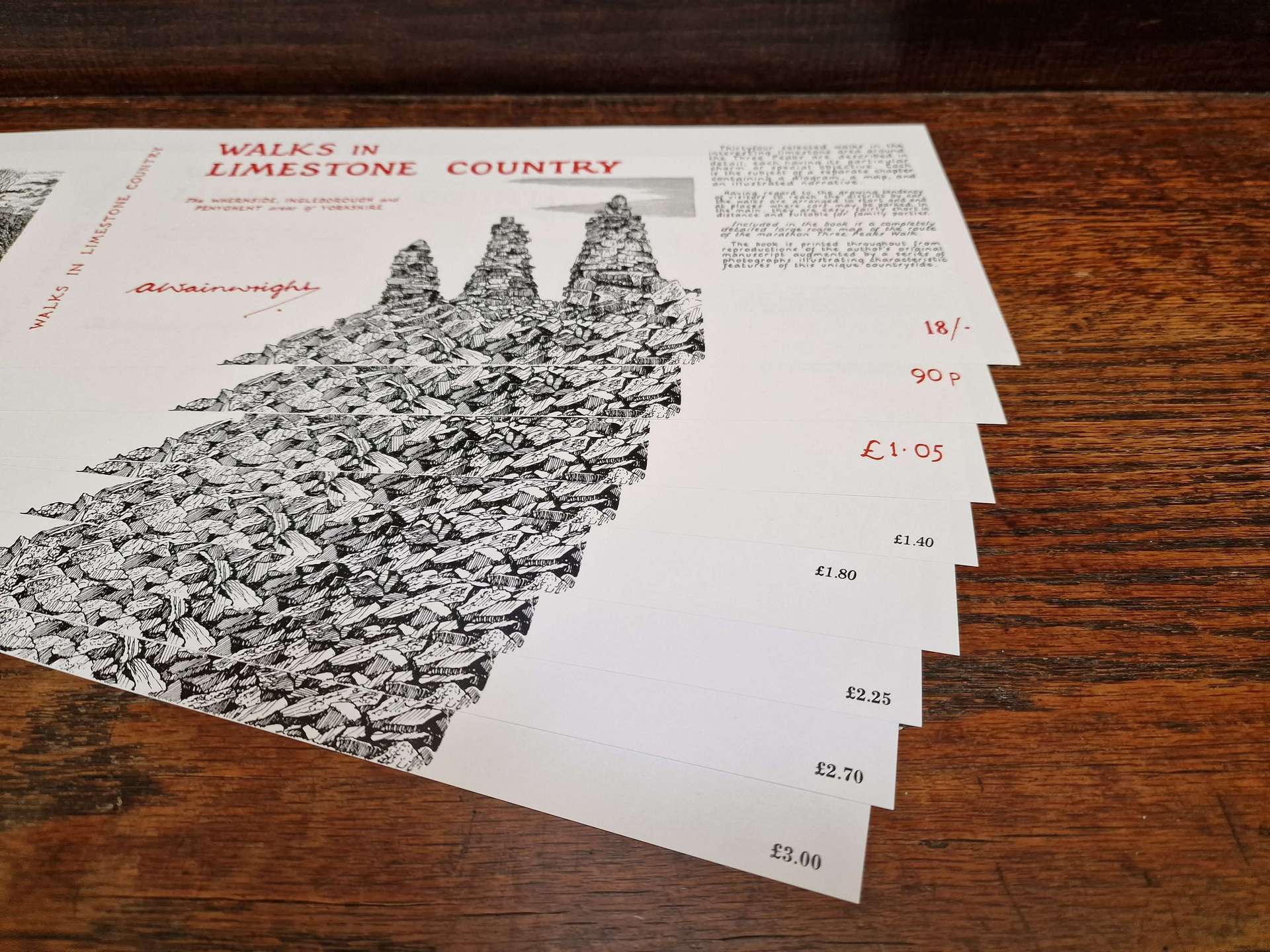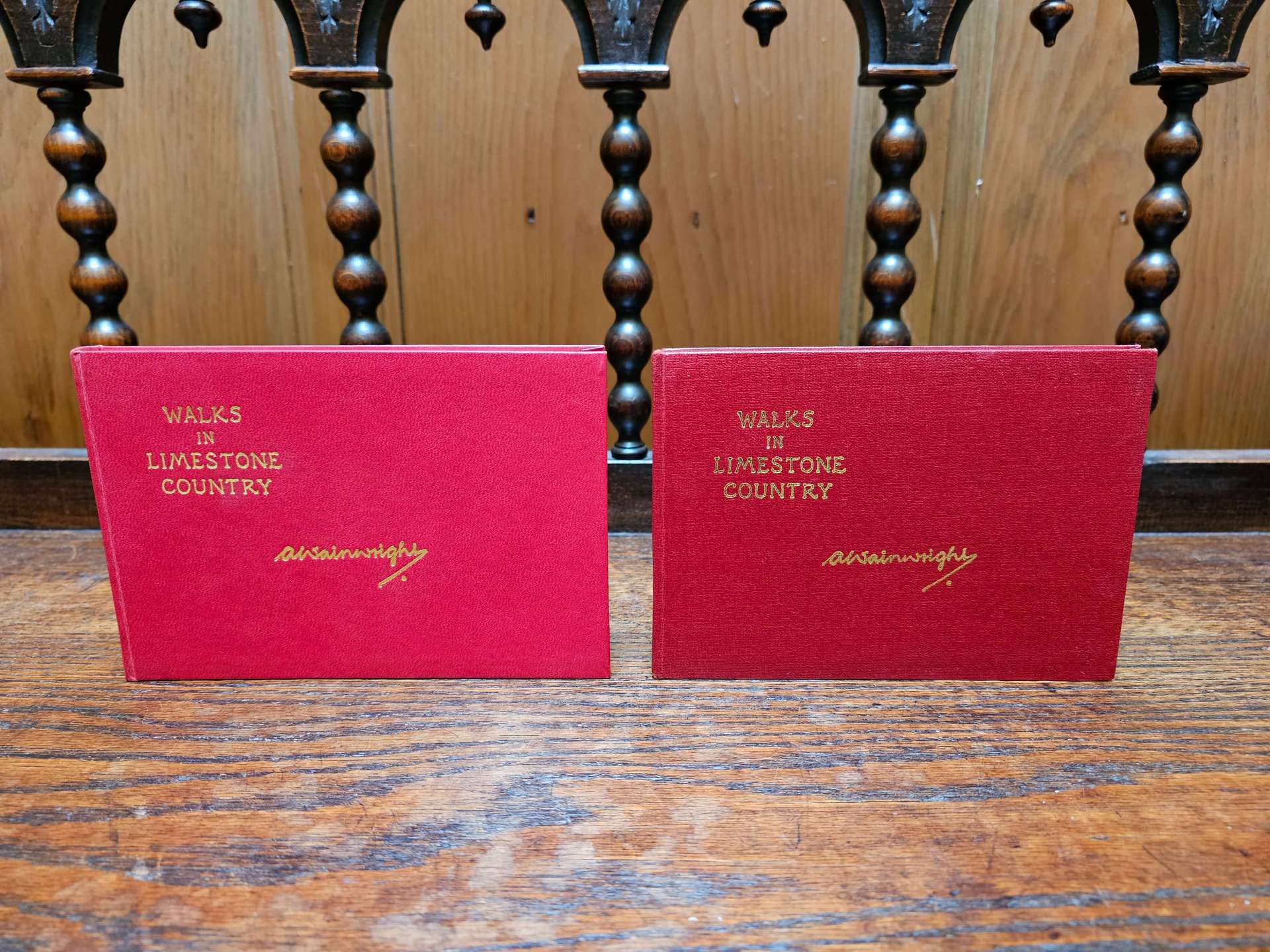Walks in Limestone Country
Walks in Limestone Country was published in April 1970 with a dedication:
“To BETTY – a charming companion on these walks”
<<>>
In the summer of 1967, Wainwright neared the completion of The Pennine Way Companion and concurrently delved into exploring concepts for a forthcoming guidebook. Initially contemplating a focus on the limestone hills of Craven, his aspirations evolved into a more expansive project. The title for this ambitious project was A Pictorial Guide to the Yorkshire Hills. Following an in-depth study of the vast expanse of the Yorkshire Dales National Park, he recognised its sheer magnitude and deemed it impractical to encapsulate in a single volume. Subsequently, Wainwright reverted to his original notion, titling The Limestone Hills of Craven project. Nevertheless, the title underwent a further revision, culminating in the final choice of Walks in Limestone Country.
In the subsequent year, Wainwright was entangled in an uncomfortable divorce with Ruth, necessitating discretion in his interactions with Betty. Seeking solace and distraction, he sought refuge in the hills, dedicating himself to creating his new book—an undoubtedly therapeutic endeavour. Wainwright’s deep affection for the Dales served as a sanctuary. Its proximity to Kendal proved advantageous, allowing him the flexibility to select optimal days for his excursions.
Following the finalisation of the divorce in the summer, Betty became Wainwright’s walking companion on numerous outings, generously serving as his chauffeur in her car. The union of Wainwright and Betty culminated on 10 March 1970, a mere four weeks before the publication of Walks in Limestone Country. The book, a testament to his resilience and newfound happiness, mirrored the journey that paralleled his personal life.
- Additional information was sourced from Wainwright’s letters to Betty

Wainwright details thirty-four walks within the book’s pages, complete with maps and clearly defined objectives. Conveniently, all the featured walks are easily reachable by car and strategically located north of the A65, in proximity to the iconic Three Peaks: Pen-y-ghent, Whernside, and Ingleborough. This geographical focus not only enhances accessibility but also adds to the allure of exploring the picturesque landscapes.
The book emerged as a notable success for the Westmorland Gazette, maintaining its popularity throughout the 1970s and 80s. Despite the Yorkshire Dales being somewhat overshadowed by the more popular Lake District, Walks in Limestone Country demonstrated remarkable sales figures, nearly rivalling the annual copies sold of The Far Eastern Fells. The enduring appeal of Wainwright’s meticulously crafted guidebook testified to its enduring relevance and admiration among avid walkers and enthusiasts.
In November 1985, a compelling new BBC TV series featuring Wainwright premiered in the North East, reaching a national audience in May of the following year. The first episode, titled ‘Wainwright in Limestone Country,’ opened with a captivating scene atop the summit of Pen-y-ghent, two miles east of Horton-in-Ribblesdale. Against this scenic vantage point, viewers were introduced to Wainwright, marking the initial encounter with this fascinating personality for many in the walking community.

<<>>
A First Edition is identified by:
- Red case with round corners and gold blocking
- 18/- price on the dust jacket
- No impression number


Shortly before the second impression of Walks in Limestone Country went to print, the price was raised to 21/-. Due to the limited number of copies from the initial print run, the Gazette opted to cover the original 18/- price with a sticker rather than produce new dust jackets. Consequently, a copy of the book adorned with the 21/- sticker essentially signifies a First Edition, adding a distinctive touch to its collectable value.

The guide underwent a notable change as it was presented in a landscape format for the first time. Simultaneously, this edition marked the end of the practice of featuring round corners on the case. Interestingly, the subsequent publication, Wainwright’s A Coast to Coast Walk, released three years later, would adopt the same case colour.
During my research at Titus Wilson, I was pleasantly surprised by the abundance of printing materials unearthed for this title. The original negatives, untouched since 1992, were discovered in impeccable condition, having weathered the passage of time remarkably well. These negatives were thoughtfully stored alongside the surviving artwork and the printed sheets, all of which the Gazette had initially produced. The well-preserved state of these materials provided a comprehensive understanding of the publication’s history.




With the advent of decimalisation in the UK in February 1971, the second impression of Walks in Limestone Country saw a price adjustment to 90p. However, navigating through the nuances of pricing becomes intricate, as a handful of 90p-priced books have unexpectedly turned out to be First Editions—an aspect that can perplex collectors.
Shortly after the new dust jackets were printed, the price experienced another bump to £1.05. Many jackets were strategically stickered over to economise, sparing them from destruction. Notably, some First Edition guides even bear jackets priced at £1.05, adding a layer of complexity for collectors. If you’re fortunate enough to possess a copy with the original 90p jacket untouched by stickers, consider it a rare find.




Few original dust jacket negatives survived, yet my luck prevailed when I discovered one dating back to the mid-1970s. This particular negative, skillfully preserved, bore the marks of its age, exhibiting numerous spots treated with a pink opaque. The spotting was the handiwork of Clifford Turner, who had worked with the negatives during this period. Turner’s contribution added an intriguing layer of craftsmanship to the historical artefacts, offering a glimpse into the intricate processes of that era.




In line with the trend observed across all Pictorial Guides in the 1970s, Walks in Limestone Country underwent significant changes by bidding farewell to its iconic red colour. By 1975, the guide had achieved considerable success, reaching its fourteenth impression and maintaining robust sales. However, unforeseen challenges arose as shortages in case material from the Gazette’s supplier in Nuneaton prompted a change in the case colour to beige. Accompanying this alteration was a price increase, raising the cost to £1.40.
The guide’s popularity continued to soar, with 1976 marking an impressive eighteen impressions. During this period, the case material transitioned to a green rexine, although no immediate price adjustment accompanied this change. It wasn’t until the following year that a subsequent price increase was implemented.





The 1980s ushered in a series of changes for the guides. Before the close of 1980, the gold blocking on the front of the case was eliminated. Although gold blocking would later make a resurgence for numerous guides, Walks in Limestone Country did not witness its return. The decision to forego gold blocking on this guide was final.
By 1982, a significant shift occurred as the printed dust jacket prices were phased out, giving way to price stickers. Subsequently, in 1985, the impression numbers reached such heights that they were deemed inconsequential. The Gazette decided to cease printing, and by the end of 1986, all impression numbers were out of circulation.


Engaging in the pursuit of collecting allows one to discern the various case types employed over the decades. Becoming familiar with the dust jacket price and impression number is a reliable guide to accurately dating any specific guidebook.

The Three Peaks Walk was prominently featured in Walks in Limestone Country and gained significant popularity during the 1980s. Notably, in 1985, Wainwright introduced a certificate to honour individuals who completed the walk. The origin of this idea remains uncertain, leaving open the question of whether it was conceived by Wainwright himself or suggested by someone who approached him with the concept. The certificate added an extra layer of recognition and accomplishment to those who undertook the Three Peaks Walk, contributing to its allure during that period.
In a meeting held at Wainwright’s residence in Kendal, the renowned author unveiled the meticulously handcrafted certificate to Andrew Nichol, the General Printing and Book Publishing Manager at the Gazette. Over a cup of coffee, the two discussed the logistics of printing and issuing the certificate. Contemplations included whether it would bear a signature or a stamp. Wainwright opted for practicality during the meeting and suggested creating a round rubber stamp. He enthusiastically handed the certificate to Andrew to begin reproducing them.

After pondering the matter for a few days, Andrew had concerns about a critical aspect: how could an applicant reliably verify that they had completed the Three Peaks Walk? Considering that the Gazette would be responsible for producing the certificates, he grappled with the notion that unvalidated certificates might be issued without concrete proof, a scenario that he believed would reflect poorly on the newspaper.
Had Wainwright approached Andrew when he succeeded Harry Firth as General Manager in 1982, Andrew would likely have readily produced the certificate without hesitation. However, by 1985, with Andrew successfully steering the general printing department back into profitability, he became more cautious. Focused on maintaining the Gazette’s positive standing, he was reluctant to risk producing anything that might leave the newspaper susceptible to criticism or the issuance of certificates without robust validation. The changing circumstances and Andrew’s commitment to upholding the Gazette’s reputation were significant in his considerations.

The subsequent week, Andrew candidly conveyed to Wainwright the reasons behind his inability to proceed with the certificate project. Understanding Andrew’s concerns, Wainwright accepted the decision gracefully, and the matter was not revisited. Several years later, while going through his drawer, Andrew unexpectedly stumbled upon the certificate and the manuscripts for Ex-Fellwanderer and Fellwalking with a Camera. Upon returning them to Wainwright, expecting them to be of value, Wainwright casually remarked, “Oh, I don’t want them; they are no good to me. You have them if you want.”
In 2010, Ken McNaughton, a dedicated Wainwright enthusiast, acquired the certificate and a collection of other Wainwright-related items from Andrew. Notably, the certificate had three missing graphics, likely lost during its storage at the Gazette. Ken, keen on preserving the certificate’s integrity, identified the absent components and carefully extracted them from an old Walks in Limestone Country copy. Meticulously framing the reconstructed certificate alongside a brief description, he created a comprehensive display showcasing this Wainwright history piece.

The Book Publishing Department at the Westmorland Gazette experienced a surge in activity during the mid to late 1980s. In 1987, the Managing Director of Westminster Press, Frank Barlow, shifted book printing responsibilities to Titus Wilson. Subsequently, Titus Wilson also assumed control of the General Printing Department at the Gazette. This transition proved opportune for Titus Wilson, coinciding with their search for new premises. Nevertheless, many at the Gazette met the news of this change with disappointment. Read The Gazette Prints its Final Book for the whole story.
Andrew Nichol decided to step down, opting for early retirement. This led to the Gazette’s publication of their last Wainwright books in the autumn of 1991.

Before his retirement in May 1992, Andrew Nichol played a pivotal role in facilitating the transfer of publishing rights to Michael Joseph. The new book launch was strategically planned for April 1992, with Titus Wilson in Kendal handling the printing process. The retail price for each book was set at £8.99, and notably, no box sets were produced for this release.
A comprehensive redesign was undertaken for the dust jackets, emphasising Walks in Limestone Country and Walks on the Howgill Fells. Notably, these jackets underwent substantial alterations, incorporating distinct coloured bands to match the other guides in the series. This redesign aimed to present a visually appealing aesthetic across the entire collection.




Following the initial launch, Michael Joseph shifted the book printing operations to Clays Ltd, Bungay, where they continued for a decade. This relocation proved to be a significant blow to Titus Wilson and Kendal. Despite numerous additional impressions being produced in Bungay, no evidence indicates that Walks in Limestone Country underwent further reprints under Michael Joseph’s direction.

Amid declining sales, Michael Joseph discontinued the publication of the books in January 2003, marking the first instance of the guides being out of print since 1955. The uncertainty loomed: was the Wainwright era now concluded? Fortunately, Frances Lincoln successfully secured the bid to republish them, and just a month later, the books returned to Kendal. This development brought immense relief and joy to many, notably Titus Wilson, who inked a new printing contract. With this turn of events, Wainwright’s legacy had returned home.
Frances Lincoln’s new book launch in April 2003 proved a resounding success. Priced at £11.99 each, except Walks in Limestone Country and Walks on the Howgill Fells, retailing at £10.99, the books garnered widespread acclaim. Such was the demand that Titus Wilson, tasked with the printing, needed to hire additional staff and expand its premises to keep up with production.
Frances Lincoln adhered to Michael Joseph’s guidebook designs, introducing box sets that retailed at £79.99. The publishing house celebrated the 50th Anniversary Editions two years later, as detailed in A Pictorial Guide to the Lakeland Fells. Notably, Walks in Limestone Country was not included in this set, resulting in no alterations to this particular title.


For the 50th Anniversary Editions, a unique ‘cream wove’ paper was utilised. Titus Wilson utilised leftover stock provided by James Cropper for other titles. An excerpt from the conversation about the paper is presented below, with all correspondence between Titus Wilson and Frances Lincoln meticulously preserved in the Alfred Wainwright Books & Memorabilia archive.






In 2006, facing escalating material costs, Frances Lincoln discontinued book printing at Titus Wilson and opted for multiple global printing locations. Walks in Limestone Country, for instance, was printed in China, accompanied by a price hike to £12.99. While the artwork on the dust jacket underwent cleaning for the new print, the guide remained unchanged. In 2011, the American publisher Quarto acquired Frances Lincoln but retained the name, given its established reputation in the industry.

In 2003, Kendal-based author and cartographer Chris Jesty embarked on a decade-long project to revise all twelve guidebooks. Walks in Limestone Country was among the final books he completed, eventually published in 2014. The revised edition boasted a flexibound cover adorned with a captivating photograph Derry Brabbs took. The Wainwright Society republished this title in 2021.

From left to right:
Walks in Limestone Country (SE), F. Lincoln 2014
Walks in Limestone Country (SE), W. Society 2021
I was fortunate to acquire the remaining stock of the Walks in Limestone Country – Second Edition for the archive. Initially, I intended to preserve these copies, but a change of heart occurred when collectors expressed interest in obtaining one. In a gracious gesture, Chris Jesty agreed to sign each for the community, adding a personal touch to this edition.



